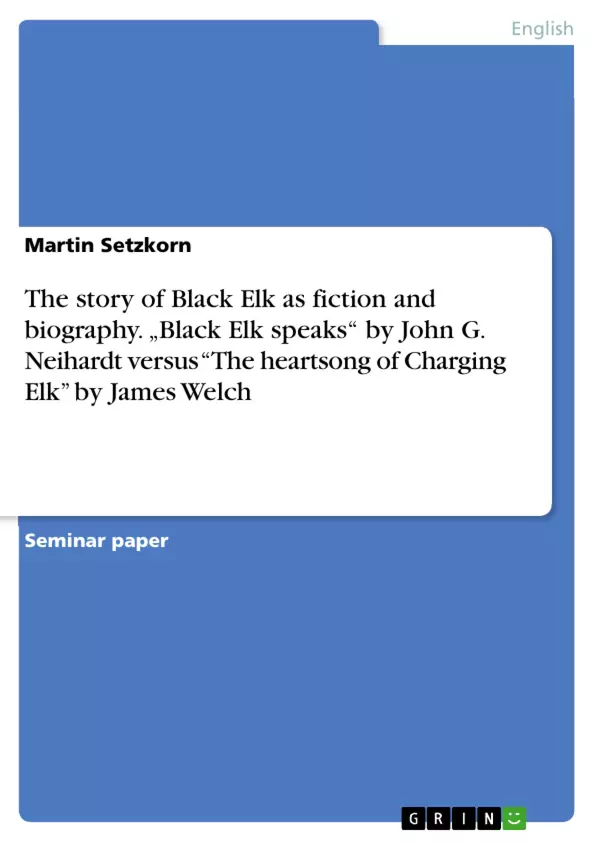In this paper I am going to compare the biography “Black Elk speaks” written by John G. Neihardt with the novel “The heartsong of Charging Elk” written by James Welch. Both books show a different perspective on the same topic. “Black Elk speaks” shows the true history whereas the novel from James Welch is fiction. But by reading both books I got the impression that even “The heartsong of Charging Elk” could have really happened. By reading the books a lot of connections or links get obvious.
The paper tries to discuss some of the connections. In the first part of the paper the stories will be summarized and the main characters Black Elk and Charging Elk will be described. In the center part of the paper some of the connections and links will be compared more detailed. Here I will triy to point out especially the connections they have during their travel to Europe.
In the last part I am going to discuss the interesting changes of the narrative perspective and the resulting impression for the reader.
Table of Contents
- Introduction
- Characterization and appearances of the main characters
- Charging Elk
- Black Elk
- Summary of the stories
- "The heartsong of Charging Elk"
- "Black Elk speaks"
- Links between the books
- Connections between the two texts especially connections in the travel to Europe
- Atlantic as a border
- Death song
- The Buffalo Bill Show
- The visions and spirit journeys
- The Massacre at Wounded Knee
- Narrative perspectives and the impression on the reader
- Conclusion
Objectives and Key Themes
This paper aims to compare the autobiography "Black Elk speaks" by John G. Neihardt with the novel "The heartsong of Charging Elk" by James Welch. While both books explore the same theme of Native American life, they offer different perspectives – "Black Elk speaks" presents a historical account while "The heartsong of Charging Elk" is a fictional narrative. The paper examines the connections and links between these two texts, analyzing how they portray similar events and characters, particularly focusing on their depictions of the Native American experience during the westward expansion. Key themes explored include:- The impact of colonization and cultural displacement on Native American life.
- The resilience and adaptability of Native American cultures in the face of oppression.
- The contrasting perspectives of historical accounts and fictional narratives.
- The influence of individual experience on broader historical narratives.
- The power of storytelling to preserve and transmit cultural knowledge.
Chapter Summaries
The paper begins with an introduction that outlines its purpose and methodology. It then dives into character analysis, comparing the depictions of Charging Elk and Black Elk in both works. The next section summarizes the two stories. For "The heartsong of Charging Elk," it follows Charging Elk's journey from his traditional Lakota upbringing to his time at the Red Cloud Agency, his escape to Whirlwind Compound, and his eventual participation in the Buffalo Bill Show. The summary highlights how these events shape Charging Elk's character and illustrate the growing pressures of white colonization. Finally, the paper explores the connections between the texts, particularly regarding the characters' travels to Europe. This section analyzes the Atlantic as a symbolic border, the role of the death song, the impact of the Buffalo Bill Show, and the spiritual journeys of both characters. The paper concludes by discussing how narrative perspectives shape the reader's understanding of the story and the historical context surrounding it.
Keywords
The key terms and topics covered in this paper include Native American history, colonization, cultural displacement, Lakota culture, autobiography, fiction, historical accounts, narrative perspectives, westward expansion, Buffalo Bill Show, and the Massacre at Wounded Knee. The paper also explores the concept of "Wasichu" and its implications for understanding the relationship between Native Americans and white settlers.- Quote paper
- Martin Setzkorn (Author), 2006, The story of Black Elk as fiction and biography. „Black Elk speaks“ by John G. Neihardt versus “The heartsong of Charging Elk” by James Welch, Munich, GRIN Verlag, https://www.grin.com/document/115491



